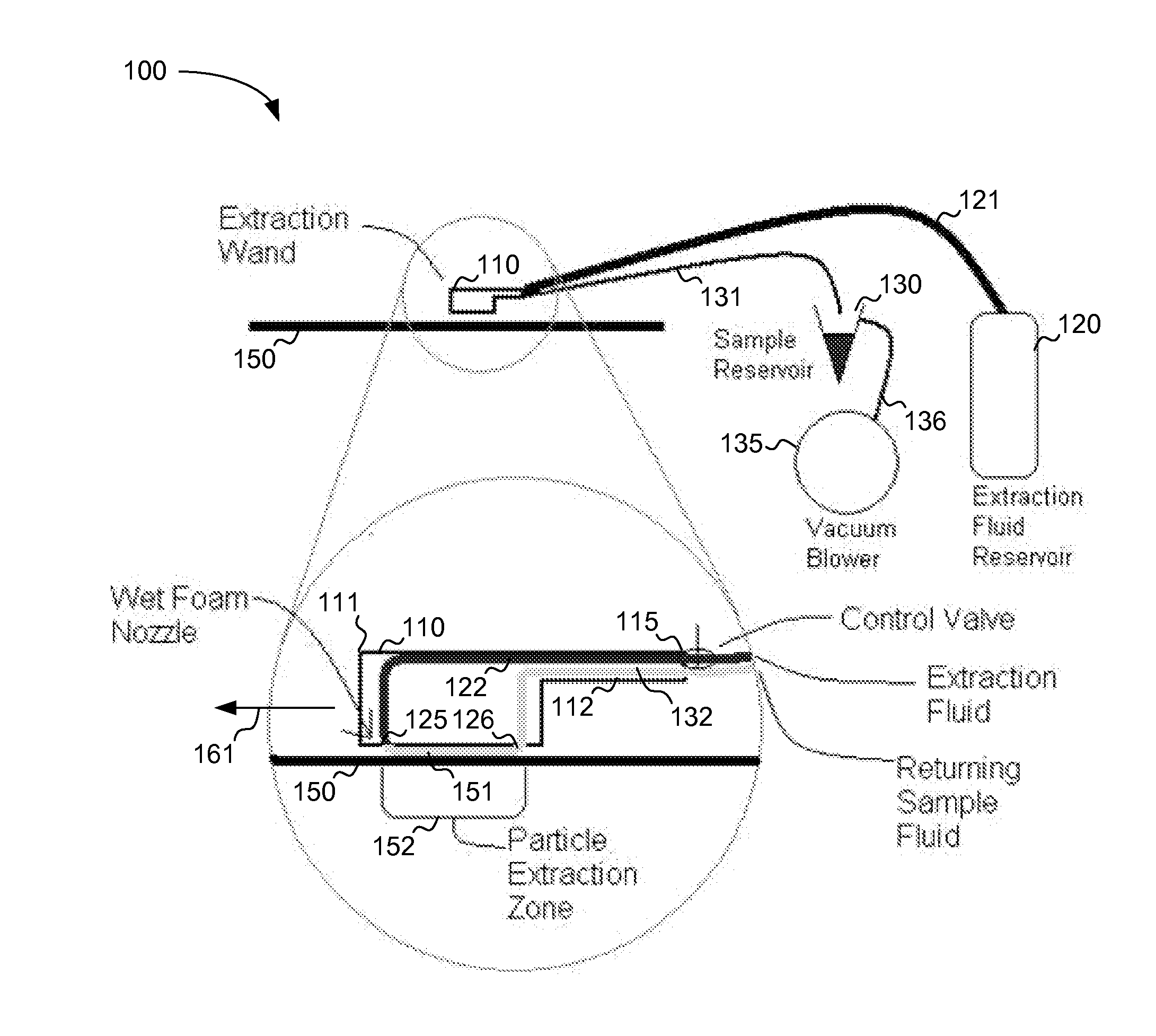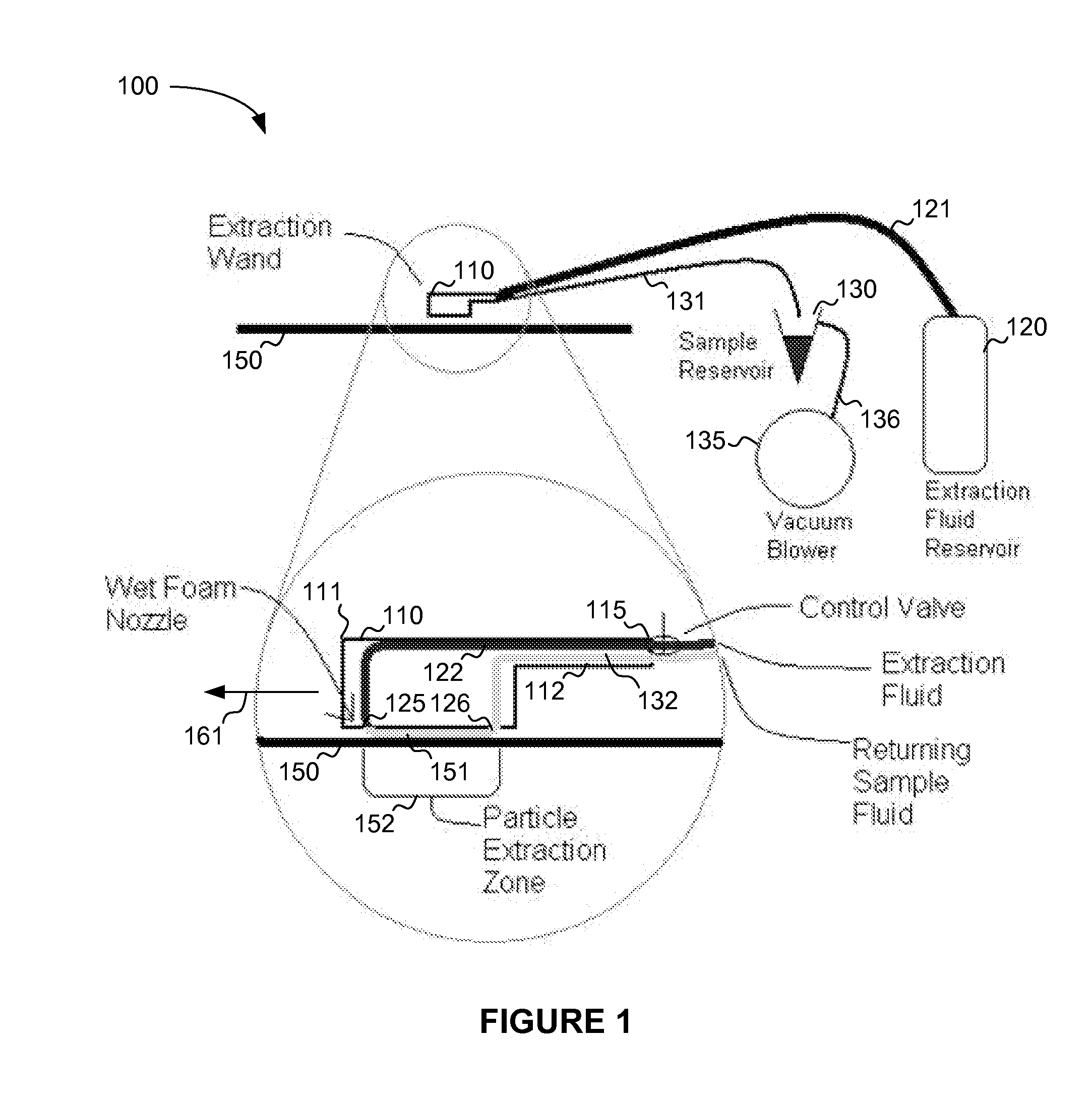[0012]The present invention relates generally to the fields of bioterrorism security,
medicine, food and beverage
quality assurance and environmental science. Since the postal anthrax attacks of 2001 and the subsequent war on terrorism, many biothreat agent sampling and detection devices have been developed, and many new devices are now in development. In the field of bioterrorism defense and security, the invention described here can be used to sample surfaces during the
threat assessment phase, and also to check for any remaining
contamination following cleaning and decontamination efforts. The invention described herein can be used in conjunction with
hazard assessment and critical control points (HACCP) planning and monitoring, and in field investigation for the sources of
contamination on
solid food items such as but not limited to
spinach leaves, tomatoes, peppers, and pistachios. In the field of
medicine, in particular
pathology, samples taken from surfaces in surgical suites can help determine the effectiveness of cleaning procedures. In the field of environmental science, field samples taken from surfaces in the course of
biological studies or investigations may contain
biological particles of interest. Where samples taken contain low concentration of particles of interest, concentration of such materials is advantageous, and the liquid sample resulting from sampling using this invention is amenable to concentration using conventional concentration methods available in the market. Further, the present surface sampling and concentration
system is compatible with test particles, such as the Biological Particulate Matter Analogue disclosed in U.S. Pat. No. 7,179,596, which is incorporated by reference herein in its entirety,
a DNA-tagged
polystyrene microsphere packaged in a metered
dose aerosol dispenser (marketed by Evogen, Inc., as the “BioSim”) for safely training and testing bioterrorism response and cleanup team procedures, food and beverage or surgical suite contamination scenarios, or performing environmental and epidemiological studies with regard to
biological particles.
[0013]A novel surface and object
sample extraction device,
system and method are disclosed which use a “wet foam” method. The surface sampler and object extractor embodiments described herein offer significant advantages over previous methods of biological particulate matter samplers including swabs, wipes, sponges and spray wash methods described above. Like swabbing, wiping, sponging, and spray washing and the other known conventional methods, the present invention extracts the sampled particles from the surface being sampled prior to analysis, but with many advantages: 1) The liquid volume of the sample produced per unit area sampled is reduced because the wet foam used to extract the particles from the surface quickly collapses to a fraction of its original volume upon collection. 2) This method is more efficient at removing particles from the sampled surfaces, resulting in collected fluid with a proportionally higher concentration of target particles, allowing better detection in devices such as multi-well plate readers that utilize small input samples. 3) This device is much more readily adapted to automated systems than hand operated swabbing and sponging techniques 4) This surface sampling method enables the construction of smaller, lighter-weight portable surface to liquid samplers because the “wet foam” extraction fluid is supplied to the
spray nozzle under
gas pressure, rather than mechanical pumps. The only electrically powered circuit in the device, the vacuum sample
pickup, can be battery operated. This enables the sampler to be easily carried up steps, ladders, taken to sampling locations by first responders, and operated for long periods of time without operator fatigue. In the backpack configuration discussed in this disclosure, the sampler can be carried by a person wearing full MOPP gear or other
protective gear. 5) This surface sampling method allows a larger area to be sampled per unit time and per sample than swabs, wipes, and sponges because a larger volume of sampling fluid can conveniently be supplied by a rechargeable / refillable extraction fluid tank. This
advantage improves the probability of detection. 6) Shear produced in the thin film of bubbles in the “wet foam” extracts particles more efficiently than other methods. 7) Use of added
mechanical force such as megasonic or ultrasonic
waves to increase shear can further increase
sample extraction efficiency. 8) The suction wand of the surface sampler can be used to sample a large volume of standing liquid if it is present on the surface being sampled. 9) Fabric can be efficiently sampled because the wet foam spray penetrates the fibers with extraction fluid and the vacuum suction pulls a large fraction of the sample back out of the fibers. When the wet foam is applied to one side of the fabric or porous material and the vacuum is applied to the opposite side, collection efficiency is further improved for certain applications.
[0015]Collection of these particles as described here is advantageous for detection of target particles such as pathogens because capture in a liquid allows many detection and identification methods to be used. Detection of pathogens and spoilage organisms on surfaces is advantageous for the prevention of the spread of further contamination and resulting illness. Collection in a liquid also allows concentration of the captured particles into a small volume, which makes them easier to detect.
Biological materials that are suspended or dissolved in the liquid are also captured and can subsequently be identified if desired.
 Login to View More
Login to View More  Login to View More
Login to View More 


